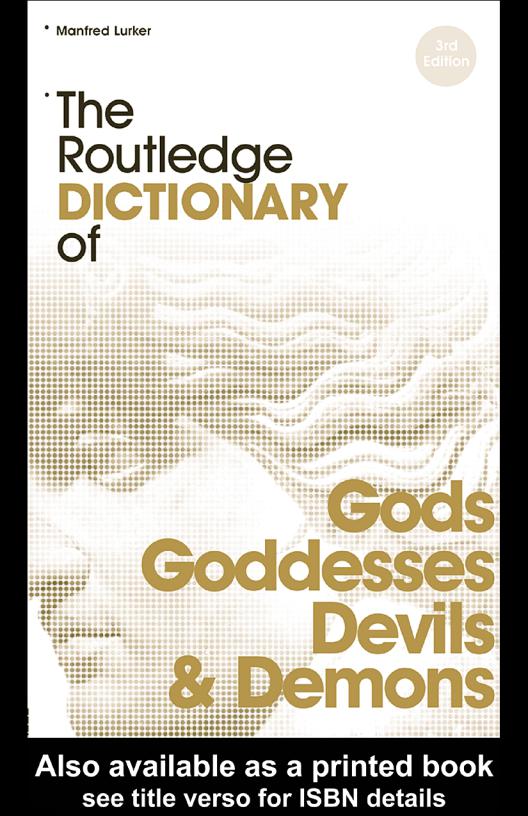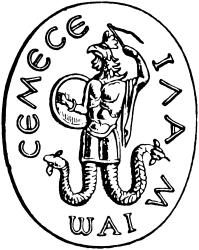
The Routledge Dictionary of Gods, Goddesses, Devils and Demons
.pdf
The Routledge Dictionary of Gods and
Goddesses, Devils and Demons
From classical Greek and Roman mythology to the gods of Eastern Europe and Mesopotamia; from Nordic giants to Islamic jinns and Egyptian monsters, this classic dictionary is packed with descriptions of the figures most worshipped and feared around the world and across time. Fully cross-referenced and with over 100 illustrations, it also features two handy appendices listing the functions and attributes shared by these deities and demons.
Covering over 1800 of the most important gods and demons from around the world, this is the essential resource for anyone interested in comparative religion and the mythology of the ancient and contemporary worlds.
Manfred Lurker was, from 1968 to 1980, editor of the Bibliography of Symbolism, Iconography and Mythology. He has published widely on symbolism and the history of religion.

The Routledge Dictionary
of Gods and Goddesses,
Devils and Demons
Manfred Lurker
First published in German in 1984 as Lexicon der Götter und Dämonen by Alfred Krämer Verlag, Stuttgart
This translation first published in 1987 by Routledge & Kegan Paul Ltd
This reissue published 2004 by Routledge
11 New Fetter Lane, London EC4P 4EE
Simultaneously published in the USA and Canada by Routledge
29 West 35th Street, New York, NY 10001
Routledge is an imprint of the Taylor & Francis Group
This edition published in the Taylor & Francis e-Library, 2005.
“To purchase your own copy of this or any of Taylor & Francis or Routledge’s collection of thousands of eBooks please go to www.eBookstore.tandf.co.uk.”
© Routledge & Kegan Paul, 1987
All rights reserved. No part of this book may be reprinted or reproduced or utilised in any form or by any electronic, mechanical, or other means, now known or hereafter invented, including photocopying and recording, or in any information storage or retrieval system, without permission in writing from the publishers.
British Library Cataloguing in Publication Data
A catalogue record for this book is available from the British Library
Library of Congress Cataloging in Publication Data
A catalog record for this book has been requested
ISBN 0-203-64351-8 Master e-book ISBN
ISBN 0-203-67189-9 (Adobe eReader Format)
ISBN 0–415–34018–7 (Print Edition)
Contents
Preface |
vi |
Note on transcription and pronunciation |
viii |
Dictionary of Gods and Goddesses, |
|
Devils and Demons |
1 |
Appendix I: functions, aspects, spheres of competence |
210 |
Appendix II: symbols, attributes, motifs |
233 |
Bibliography |
260 |
Preface
A basic element in all religions is the awareness, both intellectual and emotional, of man’s dependence on non-human powers: powers which we conceive as personal, and vis-à-vis which we normally stand in a reciprocal relationship. Gods and demons are the forms taken by these powers, their hypostatizations, as it were, in the shape of light and darkness, sun and moon, fire and water, bird and snake. The divine can reveal itself in all the phenomena of nature, just as the demonic can. But it is not only from without that the numinous presents itself to man: it can arise spontaneously in religious experience as an ‘exponent of feeling’ (Wilamowitz-Moellendorf ), and it can be divined as ‘a dark abyss . . . which is not accessible to our reason’ (Rudolf Otto). The images generated in the human mind are, then, representative of stages reached in man’s understanding and in his knowledge of himself; in a certain sense, indeed, every divine image has traits which identify it as a self-projection of mankind. As ideal beings, the gods are what man would like to be; but they are also what he, in his spatiotemporal imperfection, cannot be.
Every religion has its own conventions and symbols which serve to express the functions, the aspects and the spheres of competence of the members of its pantheon. And this means that the conscious and unconscious nexus of conventions specific to any one religion is hardly, if at all, accessible to believers in another religion, or to those who believe in no religion at all. Thus, even for the ancient Greeks the animal gods of the Egyptians were shocking and revolting. And modern man, proud as he is of his reason and logic, fares no better when he is called upon to recognize an authentic view of God in the often and – in the most literal sense – obscure rites and images of an alien religion.
Above all, we must not fail to recognize that the concepts ‘god’ and ‘demon’ are by no means evenly weighted in the various religions. The innumerable deities of Hinduism and Buddhism carry about as much significance as angels or saints do in monotheistic religions. There are mortal gods, gods who die (like Balder and Osiris) and demonic beings whom death cannot touch (for example, the Devas). The borderline between gods and demons is fluid (see Asura, or the Nymphs); and with the Christianization of a people, its erstwhile deities can be devalued to the status of devils (as in the case of Pan or Dabog) or accepted into the corpus of Christian saints (for example, Brigit Köndös). From the largely anonymous mass of spirits, gods and demons are distinguished by being more sharply and individually characterized, as shown, for example in the bestowal of names upon them.
The present reference work offers a conspectus of all the more important supernatural beings who have acquired ‘personality’ in this sense, both in the pantheons of the

Preface vii
classical cultures and in the world religions of today; and the religious systems of the so-called ‘primitive’ races are also given their due place. Any attempt at an exhaustive survey of all the names, functions, symbols and attributes in this field was excluded from the outset: the mass of material is such that even several volumes could hardly cope with it. Heroic figures in saga and legend have been included only where this is justified by their subsequent deification: thus, Aeneas and Heraklés are included, while the Celtic King Arthur and the Germanic hero Siegfried are not. The same goes for founders of religions, and for saints: the reader will find Buddha and Lao-zi in these pages, but neither Muhammad nor Zarathustra. Mythological detail has been intentionally cut to a minimum. There is no entry for Christ: for various reasons, adequate treatment of this figure lies outside the scope of the present work. The reader’s attention is directed particularly to the two appendices, in which the individual gods and demons are classified from various points of view.
The illustrations serve only to lighten the text, and are not intended to be in any way a scientifically exact iconography. It should be borne in mind that in the case of certain cultures it is hardly possible to find suitable matter for illustrative purposes and that certain peoples and religions have a pronounced antipathy to images and representation of any sort.
Manfred Lurker
Oberkirch, May 1984
Note on transcription and pronunciation
1Greek and Latin English forms in general currency are used instead of their Greek or Latin equivalents: thus, Jupiter for Iup(p)iter, Centaurs, Nymphs, etc. Apart from these special cases, Greek and Latin names are taken as in the original German text, with changes in spelling where necessary. Head-words in the origi-
nal text carry stress-marks based on: H. Hunger, Lexikon der griechischen und römischen Mythologie, 6th edn, 1969. These are retained.
2Sanskrit and Vedic Standard transcription is used for Sanskrit and Vedic names, based on Macdonell, Sanskrit-English Dictionary, OUP, 1924. The distinction between the dental series: t, d, n, s; the retroflex series: t, d, j, s; and the palatal series: c, j, ñ, f, has been retained. Here, s and f are both pronounced as sh; t, d, j are the same sounds as are heard in English t, d, n; t, d, n are their continental
counterparts (as in Italian); ñ is the Spanish ñ.
3The sh sound where it otherwise occurs – particularly in ancient Near Eastern and
Egyptian names – is transcribed as sˇ. This letter also represents sh in the two Baltic languages, Lithuanian and Latvian. In Yoruba, sh is represented by s.
4Chinese For Chinese names the modern pinyin romanization has been used, though tone marks have been disregarded; x is something like the sh in ship, q is like the ch in cheese; p, t, k are heavily aspirated; b, d, g are not voiced.
5 Wherever it occurs, zˇ is pronounced as j in French ‘journal’.
6In Aztec and Maya names, c before e and i s; before a, o, u k.

A
Aatxe (Basque, ‘young bull’) Evil spirit in the shape of a bull which, the Basques believe, leaves its cave on stormy nights, and which may often assume human form. Under the name Etsai (i.e. devil) it instructs its devotees in its arts.
Abaddon (Hebrew, ‘downfall’, ‘ruin’) In the Old Testament, the word refers to the underworld, the place of destruction (e.g. Job 26: 2; 28: 22). In the Apocalypse, it means the angel of hell, the lord of the plague of locusts (Revelation 9: 7–11). Known in Greek as Apollyon, i.e. destroyer.
Abat(t)ur A mythical figure of the Mandaeans. At the last judgment it weighs souls and/or their deeds. The name derives from Persian and is construed as meaning ‘bearer of the scales’.
Abellio A Gallic local deity, known from inscriptions in the Garonne valley. He has been interpreted as a god of appletrees.
Abgal (Apkallu) Seven Sumerian spirits deriving from the Abzu (→ Apsu) and subject to Enki. It is probable that they reflect legendary antediluvian kings. Some of the Abgal are conceived as fish-men.
Abhiyoga Generic name of the servile gods in Jainism; they help the supreme gods (→ Indra) to create rain and darkness.
Abora The supreme being worshipped by the Canary Islanders on the island of Palma. The god sat in heaven and caused the stars to move.
Abraxas
(variants Abrasax, Abraxis) Occult theonym used in Graeco-Oriental gnosticism. In Greek values, the letters add up to 365, corresponding thus to the number of days in the year. The hebdomad of letters was associated with the seven planets. Abraxas stones were used as amulets and usually show the god with the torso and the arms of a man, the head of a cock and serpent legs. In scientific literature he is also known as Angnipede ‘snake-feet’.
Abu Sumerian god of vegetation. According to one tradition he was born from the skull of → Enki, an image of the emergence of plants from the earth’s surface.
Abundantia Roman goddess personifying abundance (abundantia). She lived on in the Lady Habonde (Abundia) of
